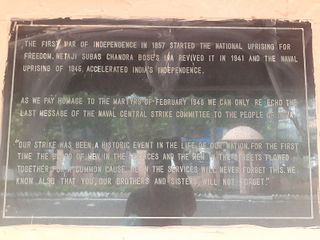1946 Royal Indian Navy Mutiny

Indian Navy Memorial
| Date of event | 18 February, 1946 |
| Location of event | Bombay |
| Type of event | Military Revolt |
Background
India in early 1940s saw high tide of strong nationalist emotions which could bring a dawn with free India. Indian leaders, including M. K. Gandhi, S.C. Bose, Vinayak Damodar Savarkar and many other were trying their ways to get India free and bring upon "SWARAJYA". Gandhi was a supporter of "non voilent" movement against the British whereas Bose had realized it earlier that non voilence was ineffective for British Governement, Freedom could not be earned with it. [ref]
INA Trials
Bose left the nation and tried to get confidence of Axis Power Nations, Japan & Germany and USSR. He called upon Indian POWs in Axis Power camps to come up & join the Azad Hind Fauj, an army led by Bose himself and recieved support from Germany and Japan. This army fought with Japanese Imperial Army in Burma and snatched Indian land for the first time from British. With monsoon of 1945, Azad Hind Fauj suffered a lot and many of its leaders were captured and sent for Trails. [ref]
Revolutionary sentiment in soldiers
Win of Bose over British in North East and Andaman Islands led a strong support coming up from Indians, specially Indain Soldiers who were then in British Forces. This was a call for mutiny! High nationalist sentiments led soldiers disobey their British seniors and provide support to Bose and his INA (Indian National Army). B. C. Dutt, a telegraphist on HMIS Talwar was one such revolutionary soldiers, he called upon for vandalism of British Symbols. Ratings of the ship with B.C. Dutt marked December 1, 1945 as "Navy Day" and painted "Jai Hind" on the walls of ship. This led to arrest of B. C. Dutt which led Indian Navy officials go on hartals but could not mark big mutiny.[ref]
Regular racial abuses, poor quality food, discrimination from british soldiers also played vital role in forming an anti-british sentiment.
"On February 18, 1946 in Bombay the ratingson board HMIS Talwar were served poor quality food to which they refused to have and they were treated inferiorly by the British officials to which they complained but were resorted with an insult saying “Beggars can’t be choosers.”. A similar abuse recorded was “You sons of coolies, you sons of Indian bitches.” This infuriated the Indian officers and the arrest of B.C Dutt added to the fury.” - THE UNSUNG HEROES OF 1946 - MAINSTREAM WEEKLY [ref]
First Sparks
As eventually reported in the Free Press Journal on 18 February,
The ‘insulting behaviour’ of Commanding Officer King infuriated the naval ratings under his command with taunts of ‘Sons of Coolies’ and ‘Sons of Bitches’. Dutt’s memoir adds the phrase ‘Sons of bloody junglees’. Anger accumulated, and a hunger strike commenced on 18 February.[ref]
Out of all reasons involved in the developing the heat, the poor quality of their breakfast seemed to arouse the strongest sentiment. The navy offered them foul-smelling, half-cooked and full of stones and husks ever since they has joined. The ratings rejected the meal, and took action. They seized vehicles and spilled into the streets of Bombay. Some drove, some ran, some marched. All headed towards the Talwar. Their momentum drew 3,000 ratings together. The ratings took a largely non-violent approach to themutiny. They even formed a Central Naval Strike Committee in anticipation of negotiations.[ref]
Demands kept by the Central Naval Strike Committee
Movement gaining mass support
At the end of 18 February, some 1,100 men on the establishment had joined the strike and whole event was made to spread over the bombay area. The next day, eleven additional shore establishments also joined the strike. The ratings boarded the twenty-plus naval ships in Bombay, and flew the Indian tri-colour flag rather than the Union Jack. This brought the total number of ratings involved to around 20,000, though some estimates place the actual number of strikers much lower—perhaps fewer than 15,000.Thus, a strike that began with a handful of veterans quickly spread to thousands.[ref]
Some 20,000 sailors on 79 Ships and many shore establishments took part. This was the last straw that broke the camel’s back in London. They realised with a shock that Wavell and Auchinleck were old India hands and were not being alarmist. What they had warned against had indeed come to pass. Just one day after the Naval mutiny the British leadership in London threw in the towel. Pethick-Lawrence announced that he and Stafford Cripps and A. V. Alexander would go to India for final negotiations. [ref]
Political interference
Royal Air Force Joins Revolt
Just twelve days before the Indian Naval Mutiny, 600 members, including officers of the Royal Indian Air Force (RIAF) camp situated close by on Bombay’s Marine Drive, had gone on a hunger strike as a protest against a racial insult by the Camp Commander. The revolt in the Navy soon spread to the ranks of the Royal Indian Air Force. Indian airmen at many airbases went on strike. They too refused to obey their British officers and shouted pro-INA slogans in Karachi and other cities.[ref]
